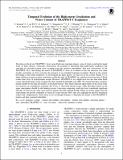| dc.contributor.author | Bourrier, V. | |
| dc.contributor.author | Bolmont, E. | |
| dc.contributor.author | Stamenković, V. | |
| dc.contributor.author | Wheatley, P. J. | |
| dc.contributor.author | Burgasser, A. J | |
| dc.contributor.author | Delrez, L. | |
| dc.contributor.author | Demory, B.-O. | |
| dc.contributor.author | Ehrenreich, D. | |
| dc.contributor.author | Gillon, M. | |
| dc.contributor.author | Jehin, E. | |
| dc.contributor.author | Leconte, J. | |
| dc.contributor.author | Lederer, S. M. | |
| dc.contributor.author | Lewis, N. | |
| dc.contributor.author | Triaud, A. H. M. J. | |
| dc.contributor.author | Grootel, V. Van | |
| dc.contributor.author | de Wit, Julien | |
| dc.date.accessioned | 2017-11-21T20:47:13Z | |
| dc.date.available | 2017-11-21T20:47:13Z | |
| dc.date.issued | 2017-08 | |
| dc.date.submitted | 2017-07 | |
| dc.identifier.issn | 1538-3881 | |
| dc.identifier.uri | http://hdl.handle.net/1721.1/112267 | |
| dc.description.abstract | The ultracool dwarf star TRAPPIST-1 hosts seven Earth-size transiting planets, some of which could harbor liquid water on their surfaces. Ultraviolet observations are essential to measuring their high-energy irradiation and searching for photodissociated water escaping from their putative atmospheres. Our new observations of the TRAPPIST-1 Lyα line during the transit of TRAPPIST-1c show an evolution of the star emission over three months, preventing us from assessing the presence of an extended hydrogen exosphere. Based on the current knowledge of the stellar irradiation, we investigated the likely history of water loss in the system. Planets b to d might still be in a runaway phase, and planets within the orbit of TRAPPIST-1g could have lost more than 20 Earth oceans after 8 Gyr of hydrodynamic escape. However, TRAPPIST-1e to h might have lost less than three Earth oceans if hydrodynamic escape stopped once they entered the habitable zone (HZ). We caution that these estimates remain limited by the large uncertainty on the planet masses. They likely represent upper limits on the actual water loss because our assumptions maximize the X-rays to ultraviolet-driven escape, while photodissociation in the upper atmospheres should be the limiting process. Late-stage outgassing could also have contributed significant amounts of water for the outer, more massive planets after they entered the HZ. While our results suggest that the outer planets are the best candidates to search for water with the JWST, they also highlight the need for theoretical studies and complementary observations in all wavelength domains to determine the nature of the TRAPPIST-1 planets and their potential habitability. | en_US |
| dc.publisher | IOP Publishing | en_US |
| dc.relation.isversionof | http://dx.doi.org/10.3847/1538-3881/aa859c | en_US |
| dc.rights | Article is made available in accordance with the publisher's policy and may be subject to US copyright law. Please refer to the publisher's site for terms of use. | en_US |
| dc.source | IOP Publishing | en_US |
| dc.title | Temporal Evolution of the High-energy Irradiation and Water Content of TRAPPIST-1 Exoplanets | en_US |
| dc.type | Article | en_US |
| dc.identifier.citation | Bourrier, V. et al. “Temporal Evolution of the High-Energy Irradiation and Water Content of TRAPPIST-1 Exoplanets.” The Astronomical Journal 154, 3 (August 2017): 121 © 2017 The American Astronomical Society | en_US |
| dc.contributor.department | Massachusetts Institute of Technology. Department of Earth, Atmospheric, and Planetary Sciences | en_US |
| dc.contributor.mitauthor | de Wit, Julien | |
| dc.relation.journal | The Astronomical Journal | en_US |
| dc.eprint.version | Final published version | en_US |
| dc.type.uri | http://purl.org/eprint/type/JournalArticle | en_US |
| eprint.status | http://purl.org/eprint/status/PeerReviewed | en_US |
| dc.date.updated | 2017-11-06T21:25:25Z | |
| dspace.orderedauthors | Bourrier, V.; Wit, J. de; Bolmont, E.; Stamenković, V.; Wheatley, P. J.; Burgasser, A. J; Delrez, L.; Demory, B.-O.; Ehrenreich, D.; Gillon, M.; Jehin, E.; Leconte, J.; Lederer, S. M.; Lewis, N.; Triaud, A. H. M. J.; Grootel, V. Van | en_US |
| dspace.embargo.terms | N | en_US |
| dc.identifier.orcid | https://orcid.org/0000-0003-2415-2191 | |
| mit.license | PUBLISHER_POLICY | en_US |
